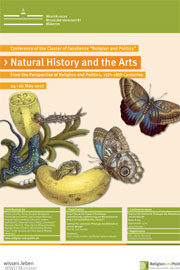Natural History and the Arts
Conference at the Cluster of Excellence "Religion and Politics"

Natural History changed in a fundamental way around 1550. Knowledge of the European flora and fauna grew exponentially. New research methods, models of description, and classification systems were developed to organize the increasing amount of information (e.g. in the works of Gesner, Clusius and Aldrovandi). The arrival of information about numerous new species discovered in Africa, Asia and the New World necessitated a comprehensive overhaul of the existing classifications.
The increase of knowledge and information has often been regarded as the main cause of the friction between the so-called traditional, ‘emblematic’ worldview and a more ‘scientific’ one – although both concepts themselves are the subject of discussion. The micro-world of insects and other small creatures became a new focus of attention, moreover,partly on account of the invention of the microscope c. 1610 in Italy and the Netherlands.
The principal issues discussed in this conference are:
- How was living nature documented in early-modern science – i.e. collected, described and depicted?
- What is the intermedial interaction between collection, description and illustration?
- How was this scientific and intermedial documentation ‘acculturated’, i.e. transposed to the visual arts and literature?
- What was, in the processes of the acculturation of Natural History, the role of religion and/or theology (e.g. Reformation and Counter-Reformation), and of politics?
Conference Natural History and the Arts from the Perspective of Religion and Politics, 15th-18th centuries
Seminar für Lateinische Philologie des Mittelalters und der Neuzeit
Room B 304
Bogenstraße 15/16
D-48143 Münster
Programme
| Thursday, 24. May | ||
| 13:00–13:15 | Welcome and Introduction | Dean Prof. Dr. Jürgen Heidrich and the organizers |
| 13:15–15:15 | Session 1 | |
| Die antike Vorgeschichte der Verankerung der Naturgeschichte in Politik und Religion: Plinius‘ Zoologie und das Römische Reich | Karl Enenkel, Münster | |
| Lucas Cranach and his Representation of Animals in the Garden of Eden | Paul J. Smith, Leiden | |
| 15:45–17:45 | Session 2 | |
| Die Therobulia des böhmischen Humanisten Johannes Dubravius (1486-1553). Ein Fürstenspiegel in Gestalt eines Tierparlamentes | Alexander Loose, Halle | |
| Between the Fable and Natural History: Marten de Vos’s Representations of Animals in Late 16th Century Antwerp | Amanda Herrin, Leiden | |
| Friday, 25. May | ||
|---|---|---|
| 09:00–11:00 | Session 3 | |
| The Species and Beyond: Hybrid Animals | Karl Enenkel, Münster | |
| Are Cranes Republicans? A Short Chapter in Political Ornithology | Sabine Kalff, Berlin | |
| 11:15–13:15 | Session 4 | |
| Pious commodification. The Passion Flower and the Bird of Paradise as Motifs in 17th-Century Spanish Visual Culture | Jose Ramon Marcaida, Madrid | |
| Natural History, Christianity, Religion and Mythology: Flemish 17th-Century Animal Paintings (Roelant Savery, Jan Brueghel the Elder) | Marrigje Rikken, Leiden | |
| 15:00–18:00 | Session 5 | |
| Natur um 1600: Ganzheitsschau und Forschungsdrang – ein Widerspruch? | Thea Vignau-Wilberg, München | |
| Der Wal als Schauobjekt: Thomas Bartholin (1616-1680), die dänische Nation und das Ende der Einhörner | Bernd Roling, Berlin | |
| Looking for a Representation of the Clove Tree: a Kaleidoscope of Words and Illustrations | Teresa Carvalho | |
| Saturday, 26. May | ||
| 09:00–11:00 | Session 6 | |
| Insects in John Ray’s Natural History and Natural Theology | Brian Ogilvie, Massachusetts | |
| Micro before the Microscope. Visual evidence of the interest in details of Nature in Protestant and Catholic Europe | Florike Egmond, Rome | |
| 11:20–14:00 | Toads, snakes and insects. Otto Marseus, Johannes Swammerdam and the study of the lowest forms of life | Erik Jorink |
| Vitalistic Physiology and Social Imagery: The Significance of Jacobite Ideology for the Natural History of Men in Early Enlightenment Thought | Tamas Demeter, Budapest | |
| Final Discussion/ Concluding Remarks | ||

